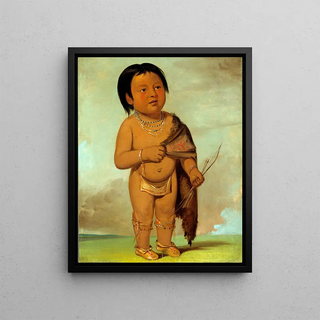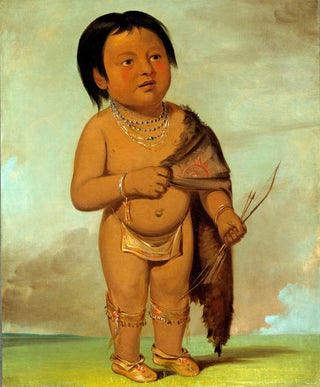Art print | Tcha-As-Ka-Ding Grandson of Buffalo Bulls Back Fat - George Catlin


View from behind

Frame (optional)
In the vast panorama of art history, certain works stand out for their ability to capture the essence of a culture and an era. "Tcha-As-Ka-Ding Grandson of Buffalo Bulls Back Fat" by George Catlin is one of these iconic pieces. Created in the 19th century, this painting bears witness to Catlin's commitment to immortalizing Native American peoples and their traditions. Every brushstroke evokes a story, an identity, and a deep connection with nature. Contemplating this artwork, the viewer is transported to a world where the values and beliefs of indigenous peoples come to life, offering a window into their daily life and rituals.
Style and uniqueness of the work
George Catlin's style is characterized by a realistic and meticulous approach, paying homage to his subjects while emphasizing their dignity. In "Tcha-As-Ka-Ding Grandson of Buffalo Bulls Back Fat," the vibrant color palette and precise details of traditional clothing reveal not only the aesthetic beauty of the painting but also the cultural richness of the Sioux. Catlin manages to capture the expressions of the characters, revealing emotions that transcend time. The composition, balanced and harmonious, invites the viewer to explore the various elements of the work, from faces to ornaments, including the surrounding landscapes. This painting is a true ode to Native American culture, and each element is carefully thought out to tell a story.
The artist and his influence
George Catlin, painter and writer, is often considered the first to comprehensively document the life of Native American tribes through his works. His journey across the United States in the 1830s allowed him to meet numerous communities, capturing their essence in his paintings. Catlin's influence is not limited to his artistic achievements; he also played a crucial role in raising awareness among the American public about the culture and challenges faced by indigenous peoples. His work paved the way for a better understanding and appreciation of Native American cultures, while highlighting the injustices they suffered.

Matte finish

View from behind

Frame (optional)
In the vast panorama of art history, certain works stand out for their ability to capture the essence of a culture and an era. "Tcha-As-Ka-Ding Grandson of Buffalo Bulls Back Fat" by George Catlin is one of these iconic pieces. Created in the 19th century, this painting bears witness to Catlin's commitment to immortalizing Native American peoples and their traditions. Every brushstroke evokes a story, an identity, and a deep connection with nature. Contemplating this artwork, the viewer is transported to a world where the values and beliefs of indigenous peoples come to life, offering a window into their daily life and rituals.
Style and uniqueness of the work
George Catlin's style is characterized by a realistic and meticulous approach, paying homage to his subjects while emphasizing their dignity. In "Tcha-As-Ka-Ding Grandson of Buffalo Bulls Back Fat," the vibrant color palette and precise details of traditional clothing reveal not only the aesthetic beauty of the painting but also the cultural richness of the Sioux. Catlin manages to capture the expressions of the characters, revealing emotions that transcend time. The composition, balanced and harmonious, invites the viewer to explore the various elements of the work, from faces to ornaments, including the surrounding landscapes. This painting is a true ode to Native American culture, and each element is carefully thought out to tell a story.
The artist and his influence
George Catlin, painter and writer, is often considered the first to comprehensively document the life of Native American tribes through his works. His journey across the United States in the 1830s allowed him to meet numerous communities, capturing their essence in his paintings. Catlin's influence is not limited to his artistic achievements; he also played a crucial role in raising awareness among the American public about the culture and challenges faced by indigenous peoples. His work paved the way for a better understanding and appreciation of Native American cultures, while highlighting the injustices they suffered.






